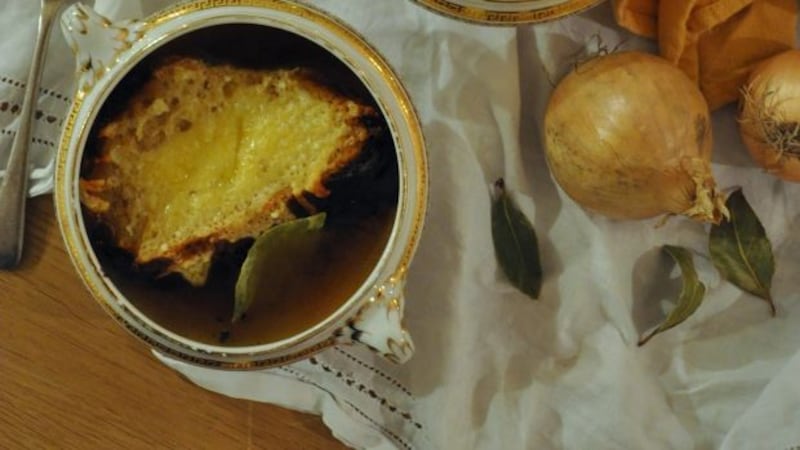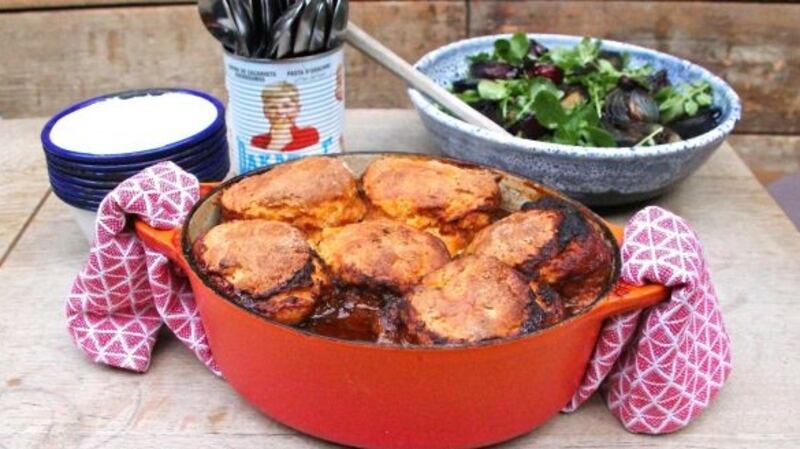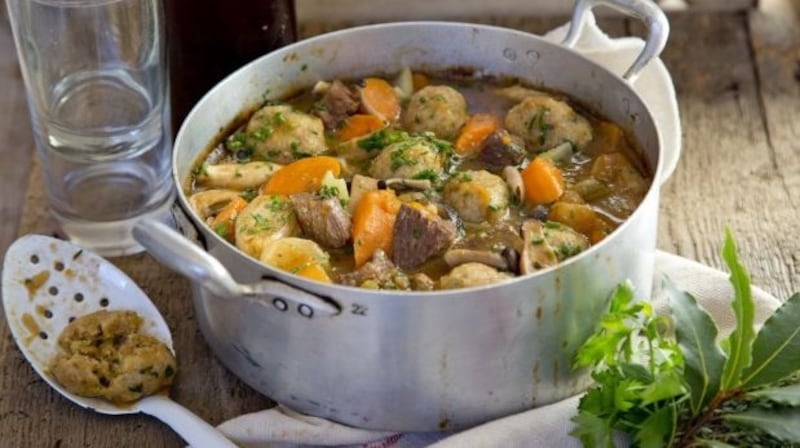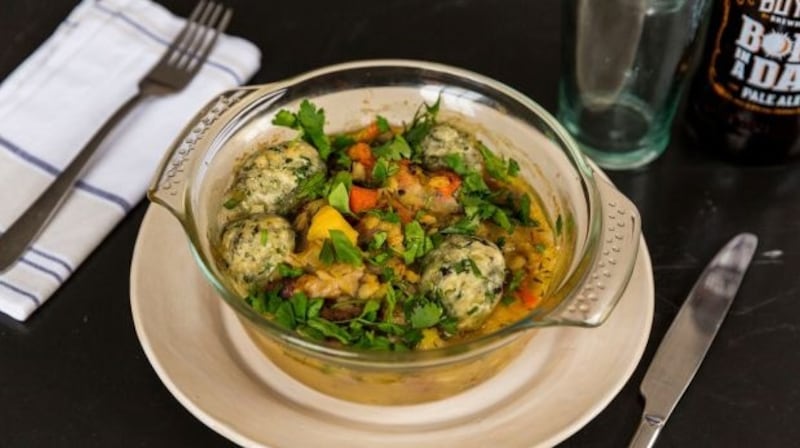Baby it’s cold outside ... so turn on the oven or the hob, take out your biggest pot or casserole dish, and conjure up some insulation in the shape of a ribsticking soup or stew. There is a bonus too – your kitchen will soon be toasty and warm, as well as filled with appetising aromas.
Is there any better cold weather meal than a bowl of steaming hot soup? Yes, a bowl of soup with a sandwich, toasted in preference, on the side. Here we have two hearty dishes that cleverly combine soup and toast, in the one bowl.
Scroll down and you'll find a few simple, tasty stews too. They've all got dumplings in them, which make them one-pot wonders, with no other carbs required. Jess Murphy calls hers "the hot water bottle of dinners", which sounds about right for the current Baltic spell.
Lilly Higgins’s French onion soup

Traditional French onion soup is a real cold weather classic. Sure, it can take a while to make – getting the onions to the necessary sweet, sticky brown stage can take up to two hours, but then you’re almost done with the cooking.
Keeping the lid on the pot while they are cooking helps to prevent the onions catching (burning) during this process. However, if you are in a hurry, adding a spoonful of sugar to the onions will help them caramelise a lot faster.
Serves: 4
Ingredients
80g butter or ghee
1tbs olive oil
1.5kg onions, thinly sliced
Sea salt and black pepper
100ml dry sherry
1½ litres beef stock (home-made or a good-quality shop bought)
1 bay leaf
1tbs Dijon mustard
1 loaf rustic sourdough bread, thickly sliced
450g Gruyère cheese, grated
Method
1. Melt the butter and olive oil in a large pan over a medium-high heat. Add the onions and cook, stirring regularly until they begin to soften. Lower the heat and cook until the onions are very sweet and golden-brown. You will need to stir them regularly and it can take one to two hours. Add a tablespoon of water if they begin to stick too much.
2. Season with salt and pepper. Add the sherry and bring to a simmer, scraping any brown bits as you stir. Leave to simmer for a minute before adding the bay leaf and stock. Leave to simmer for 20 minutes. Taste for seasoning.
3. Meanwhile, grill the thickly sliced bread on one side. Butter the untoasted side and spread thinly with a little Dijon mustard. Sprinkle the grated cheese on top of the toast, melt it under the grill and serve on top of the soup.
Jess Murphy’s Tuscan ribollita soup
The word ribollita literally means re-boiled in Italian, and this Tuscan vegetable, beans and bread broth was traditionally a farm workers’ favourite, being hearty enough to provide sustenance to last through hours of hard labour.
It is a complete meal in a bowl, and frugal too, making good use of stale bread, inexpensive chickpeas and beans. Don’t be put off by the long list of ingredients, they’re mostly things that you’ll have in your cupboard or be able to get from a corner shop. Use the dark green Savoy cabbage if you can’t get cavolo nero or kale, and really, any cabbage will do.
A big spoonful of extra virgin olive oil – Tuscan if you have it – adds a touch of luxury when drizzled over the top of the soup once you’ve poured it into a bowl.

Serves: 4
Ingredients
50ml of extra virgin olive oil
2 big carrots, cut into cubes
1 large onion (about 150g) chopped
A head of celery into cubes
200g of thickly sliced cavolo nero or dark green kale
3 red peppers diced into cubes
4 sprigs of thyme
3 bay leaves
3 smashed garlic cloves
1 fresh chilli (or 1tsp of dried chilli powder)
800ml of chicken, vegetable or vegan stock (plus extra water if required)
200g fresh tomatoes or 1 tin of chopped tomatoes
A pinch of sugar
200g tin of chickpeas
200g tin of cannellini beans
50g of Parmesan, plus extra to serve
Sea salt
Black pepper
Slices of old sourdough or stale bread
Method
1. Heat the olive oil in a saucepan.
2. Place the carrots, onion, celery, cavolo nero, peppers, thyme, bay leaves, garlic and chilli in the pan and cook over a medium heat until softened, stirring frequently, for about five minutes.
3. Add your stock, tomatoes and sugar and leave the pot to simmer on a low heat for about 30 minutes or until a third of the liquid has evaporated.
4. Rinse the chickpeas and cannellini beans in a fine sieve and add them to the stock with the freshly grated Parmesan and allow to heat through. This is a good time to season, but remember Parmesan is salty, so be careful.
5. Scoop the ribollita into warm soup bowls. I like to serve with a slice of sourdough on top, toasted and brushed with butter, then grate extra Parmesan over the hot bread and soup.

A good stew is food of the gods when the mercury dips, and those that are a complete meal in one pot are even more appealing. Dumplings, the flour and fat balls that are part-boiled, part-steamed in the stew – and are way more tasty than that makes them sound – are a good way of adding carbs to the pot.
Irish Times magazine columnist Jess Murphy brought a Kiwi twist to an Irish staple with her recent recipe for lamb or hogget casserole with herby dumplings.
Jess Murphy's hogget or lamb casserole with herby dumplings
Ingredients
For the stew
8 - 10 hogget or lamb neck chops on the bone
70ml rapeseed oil
1 leek
2 carrots
1 large parsnip
1/4 of a turnip
20g fresh sage, rosemary and thyme
3 garlic cloves
200g chopped water cress
2 x 500ml bottles Buried at Sea stout or similar
30g tomato paste
20g Marigold vegetable boullion
For the dumplings
250g self-raising flour
125g suet or butter
100g chopped chives
Salt and pepper
Milk to bind
Method
1. Preheat the oven to 160°C.
2. Brown the neck chops in the rapeseed oil in a large frying pan.
3. Add these with all the vegetables and herbs to a casserole dish with a tight fitting lid.
4. Mix the tomato paste and vegetable boullion with the stout and pour into the casserole dish.
5. Make sure everything is well covered in liquid, topping up with water if not. Bring everything to the boil on the hob and then put on the tight-fitting lid and transfer to the oven. The longer you can leave this one in the oven, the better. Leave the lid on and keep at a low heat until the meat falls off the bone - at least three hours.
6. Meanwhile, to make the dumplings, rub the flour and fat together using your finger tips as you would if you were making scones. Add the chives and seasoning and a drop of milk at a time until the mixture comes together.
7. When the meat is cooked to your satisfaction, put the dumpling mix in small even sized pieces on top of the casserole and bake for a further 15 minute with the lid off, until golden.
Vanessa Greenwood’s beef stew with wild mushrooms, red ale and cheesy dumplings

Vanessa Greenwood’s recipe would be excellent made with shin beef, ask your butcher for it. The connective tissue that is found in this hard working muscle breaks down in the slow cooking process and you are left with meltingly tender meat.
Serves: 6
Ingredients
1kg stewing beef, large chunks, trim off fat
2- 3 tbsp sunflower oil
12 shallots, peeled
2 celery stalks, cut into large chunks
2 cloves garlic, peeled
2 sprigs fresh thyme
1 tbsp sherry vinegar (or water)
3 carrots, large diagonal discs
125g wild mushrooms, wiped clean (slice if large)
25g butter
2 tbsp tomato purée
1 tbsp plain flour
1 bouquet garnis (parsley, bay, thyme)
500ml beef stock
500ml Irish craft ale
10g parsley, chopped
Salt and freshly cracked black pepper
For the cheesy dumplings:
200g mature Cheddar cheese, grated (or Gubbeen)
100g wholemeal flour
15g parsley, chopped
Quarter tsp sea salt
2 egg yolks
1 tbsp milk
Method
1. Preheat an oven to 160°C/gas 3. Season the meat. Heat two tablespoons of oil in a flameproof casserole over a high heat and working in batches, brown the meat. Remove and set aside.
2. Adding more oil, sauté the shallots, celery, garlic cloves and thyme, adding sherry vinegar as the vegetables start to catch. Add carrots and sauté until slightly browned. Add the mushrooms, cook for two minutes. Stir in butter and tomato purée for one minute before adding flour, stir to cook for two minutes.
3. Return the beef to the casserole, add bouquet garnis, stock and ale. Bring the casserole just to the boil, cover and transfer to the preheated oven for one and three quarters hours, until the meat is tender, stirring halfway through.
4. Meanwhile, to make dumplings mix together the cheese, wholemeal flour, parsley, salt and egg yolks in a bowl, add enough milk to shape 15 walnut size dumplings. Season the stew and gently press the dumplings into it. Return to the oven, uncovered, for 20 minutes, or until the dumplings pop to the surface. Lastly, add chopped parsley.
Carmel Somers’s Irish stew with parsley and dulse-crusted dumplings

Dumplings crop up again in Carmel Somers’s Irish stew. There are as many versions of this classic as there are cooks. Hers has more veg than usual, is thickened a little with pearl barley, and topped with dumplings seasoned with ground dulse. Dried seaweed is readily available now, but if you don’t have it leave it out.
Serves: 4
Ingredients
1.35 kg neck fillets of lamb and nest end of neck cutlets (mixed)
2 tbsp seasoned plain flour
350g onions, thickly sliced
225g carrots, cut into chunks
2 medium leeks, washed and sliced
1 large potato, peeled and cut into chunks
1 rounded tbsp pearl barley
Salt and freshly milled black pepper
For the dumplings:
175g self-raising flour
6tbsp fresh parsley, chopped
75g butter
1tbsp ground dulse
Salt and freshly milled black pepper
To garnish:
1 tbsp fresh parsley, chopped
Method
1 Start off by drying the pieces of meat on kitchen paper, trim away any excess fat, cut the fillets into 1 1/2 - inch (4cm) rounds, then dip them along with the cutlets into the seasoned flour. Now arrange a layer of meat in the base of the casserole, followed by a layer of onion, carrot, leek and potato, and a good seasoning of salt and pepper. Then add some more meat and continue layering the ingredients until everything is in.
2. Next sprinkle in the barley and pour in approximately 2 pints of hot water and bring it to a simmering point. Spoon off any scum that comes to the surface, cover with a well-fitting lid and leave it to simmer on the lowest heat for two hours.
3. About 15 minutes before the end of cooking, pre-heat the oven to 200 degrees Celsius, then make the dumplings. Rub the butter into the flour add the seaweed and parsley with a good seasoning of salt and pepper. Now add sufficient cold water to make a fairly stiff but elastic dough that leaves the bowl clean. Knead it lightly, then shape into 12 dumplings.
4. When the stew is ready, remove the lid, place the dumplings all over the surface, then transfer the casserole to the highest shelf of the oven (without a lid) and leave for 30 minutes or until the dumplings are golden brown and crusty. Serve the meat surrounding the vegetables and dumplings with some of the liquid poured over and some in a gravy boat, and sprinkle with chopped fresh parsley.











